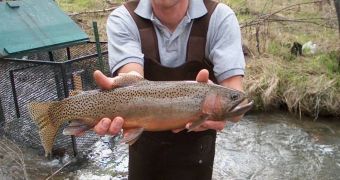A collaboration of American researchers demonstrated in a new study that the lifetime movements of trout in large river systems can be tracked by analyzing their earbones. These results may be used to develop a new method of studying the fish unobtrusively.
Details of the research were published in the latest issue of the Canadian Journal of Fisheries and Aquatic Sciences. Investigators determined that variations in strontium isotopes present in the otoliths (earbones) of Westslope cutthroat trout can be correlated to those found in river systems.
As such, the two types of variations can be compared in order to create a map of how the fish traveled through a specific large river system over the course of their lifetime. This is the first study to demonstrate that such a correlation is possible, and that it can yield viable data.
The work was carried out by experts with the US Geological Survey’s (USGS) Northern Rocky Mountain Science Center (NRMSC), Woods Hole Oceanographic Institution (WHOI), Montana State University (MSU), and Montana Fish, Wildlife & Parks (FWP).
Researchers say that the new method complements traditional fish-tracking techniques, potentially boosting the amount of data that biologists can obtain on river ecosystems and their fish populations.
“It worked so well! The values in the water matched those in the otoliths, which grow like rings in a tree. As fish grow and move into new environments, the otoliths record that information and we matched that with stream statistics to reconstruct the entire life cycle of a fish,” says Clint Muhlfeld.
The expert holds an appointment as a scientist at the USGS, and was also the lead author of the study.
In addition to revealing the lifetime travels of river “residents,” the new approach may also reveal how invasive species make their way into these ecosystems. Non-native species, habitat destruction, and fragmentation contributed to the decline of Westslope cutthroat trout in western North America.
“All life is literally a product of its chemical environment, and there is no more dramatic demonstration of that fact than the ability to retrace the life history of fish from the variations in the chemicals deposited in their ear bones as they grow and migrate through space and time,” adds Marcia McNutt.
“As this technique has already proven its scientific value in understanding the movement of fish in the marine environment and those which migrate from freshwater streams to the ocean, it is truly an achievement that could inspire 'CSI',” concludes the expert, who is the director of the USGS.

 14 DAY TRIAL //
14 DAY TRIAL //